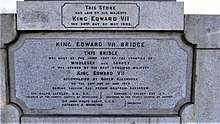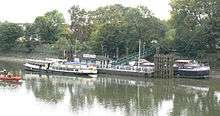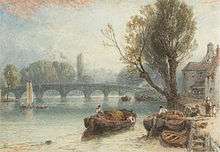Kew Bridge
Kew Bridge is a Grade II listed bridge over the River Thames in the London Borough of Richmond upon Thames and the London Borough of Hounslow.[2][3] The present bridge, which was opened in 1903 as King Edward VII Bridge by King Edward VII and Queen Alexandra,[nb 1] was designed by John Wolfe-Barry and Cuthbert A Brereton.[1] It was given Grade II listed structure protection in 1983.[2][3]
Kew Bridge | |
|---|---|
 The current (third) Kew Bridge | |
| Coordinates | 51°29′13″N 0°17′15″W |
| Carries | A205 road |
| Crosses | River Thames |
| Locale | Kew |
| Heritage status | Grade II listed structure |
| Characteristics | |
| Design | Arch |
| Material | Granite |
| Total length | 1,182 feet (360 m) |
| Width | 75 feet (23 m) |
| Longest span | 133 feet (41 m) |
| No. of spans | 3 |
| Piers in water | 2 |
| History | |
| Designer | John Wolfe-Barry and Cuthbert A Brereton[1] |
| Opened | 1903 |
Listed Building – Grade II | |
| Official name | Kew Bridge |
| Designated | 25 June 1983 (Richmond listing); 11 February 1998 (Hounslow listing) |
| Reference no. | 1193845(Richmond listing); 1376778 (Hounslow listing) |

| |
Location
Kew Bridge crosses the River Thames between Kew Green in Kew on the south bank and Brentford on the north bank. It is immediately adjacent to the Royal Botanic Gardens on the Kew side of the river and the former Grand Junction Waterworks Company buildings (now the London Museum of Water & Steam) on the north.
The bridge forms a primary route destination joining the South Circular and North Circular roads to the west of London, and is nearly always very congested. Beside the bridge on the downstream Kew bank is Kew Pier, which serves tourist ferries operating under licence from London River Services.
History
- (Taken from notes from small centenary display at Museum of Richmond, October 2003)
The Museum of Richmond has an engraving by John Barnard, architect of the design for the first Kew Bridge, dedicated to George, Prince of Wales and his mother Augusta and dated 1759. Bernard describes it as the Bridge over the River of Thames from Kew in the County of Surry to the opposite shore in the County of Middlesex. Kew and the area around the bridge was significant to George as his father Frederick took a lease on Kew House, now part of the Royal Botanic Gardens from 1731 and rebuilt the house to designs by William Kent. George's mother Augusta started the botanic gardens and created many of the garden buildings.
The first bridge was built by Robert Tunstall of Brentford who previously owned the ferry on the site. The bridge was inaugurated on 1 June 1759 by the Prince of Wales driving over it with his mother and a number of other royals, and was opened to the public three days later. Such was the excitement that over 3,000 people crossed in one day. Tolls ranged from 1 penny for each pedestrian to one shilling and six pence for a coach and four horses.

The first bridge was constructed with two stone arches at each end and seven timber arches in between, which proved costly to maintain and as a consequence the bridge only lasted 30 years. In 1782 Robert Tunstall, son of the builder of the first bridge, obtained consent to replace the bridge and work began on 4 June 1783, the anniversary date of the first bridge opening to the public. The new bridge was designed by James Paine who had previously been responsible for Richmond Bridge. The cost was £16,500 which was raised by means of a tontine.
The second bridge was built alongside the first, to avoid hindrance to traffic during construction work, and this time was built entirely of stone. It was again opened, on 22 September 1789, by George, who by this time had become King George III, crossing with a great concourse of carriages. The tolls were a half penny per pedestrian and 6 pence for each horse. The bridge was sold by auction to a Mr Robinson for £23,000 in 1819 and again in 1873, when it was purchased by a joint committee of the City of London Corporation and the Metropolitan Board of Works for £57,300. The exhibition included a copy of a J.M.W. Turner sketch of the second bridge from Brentford Ait circa 1805/6 with barges on the left.
The tollbooths were at the Brentford end of the bridge and were originally planned as pavilions with Doric porticos. To save on the cost rather simpler Italianate booths were built instead of brick and stucco. Tolls were abolished on 8 February 1873 and a triumphal arch was built at the Brentford entrance to the bridge. The gates were removed and paraded on a brewer’s dray through Brentford and around Kew Green.

By the 1890s it was clear that the second bridge could not really cope with the weight of traffic and in any case the approach was too narrow and steep on the Brentford side. The engineer Sir John Wolfe Barry was invited to assess the bridge in 1892 and recommended building a new bridge rather than modifications to the second one.
The Kew Bridge Act of 1898 paved the way and the third bridge was commissioned jointly by the Middlesex and Surrey County Councils at a cost of £250,000. The engineers were Barry and Brereton and the building contractors were Easton Gibbs and Son. The third bridge is 1,182 feet (360 m) long, and the largest of its three arches has a span of 133 feet (41 m). The roadway is 56 feet (17 m) wide (compared to 18 feet (5.5 m) on the second bridge), and the pavements 9 feet 6 inches (2.90 m) compared to 3 feet 3 inches (0.99 m). It was built of granite from Cornwall.
A temporary wooden bridge was put in place upstream of the second bridge before demolition during October to December 1899. The third bridge was completed for an official opening on 20 May 1903 by King Edward VII and Queen Alexandra who processed through Kensington, Hammersmith, Chiswick and Brentford on the way to the ceremony, returning via Mortlake and Barnes and re-crossing the Thames at Putney Bridge.
The centre of the bridge was provided with a tented pavilion 60 yards long and spanning its whole width. A special temporary balcony, projecting from this, was installed so that the crowds on the banks and on the water could see the royal visitors. The King laid the last coping stone with a silver trowel and declared the bridge open. He and the Queen were given a number of gifts including bouquets, a bound history of the bridge and various other commemorative items including a silver mounted prehistoric flint axe found during construction work, another axe with part of its haft remaining and a fine silver spirit level made in the shape of the bridge itself. Later the Mayor of Richmond presented a chair with the ladders in its back carved in the shape of the three bridges. The inhabitants of Brentford and Chiswick presented a 1721 silver tankard.
After the departure of the royals a huge party took place on the lawns at Kew Gardens and 1,000 children were entertained to tea in a marquee on Kew Green, an event hosted by Cuthbert Brereton.
During the silent era of film, a Kew Bridge Studios operated close to the bridge. The site was subsequently used by the Q Theatre.
Kew Bridge in art

_by_Lewis_Pinhorn_Wood.jpg)
A drawing made in 1759 by Paul Sandby, showing the first Kew Bridge built in 1758–1759 by John Barnard, and Old Kew Bridge, London by James Webb, an oil painting dating from 1876 to 1885, are held at the Museum of London.[4][5]
The oil painting Kew Bridge by Henry Muhrman (1854–1916) was painted in about 1898, when the artist was living in Gunnersbury. It is now in the Tate Gallery's collection.[6]
The Tate also holds J.M.W. Turner's pen and ink sketch The Thames at Kew with Kew Bridge (1805)[7] and his oil painting The Thames Glimpsed between Trees, possibly at Kew Bridge c.1806-7.[8]
Myles Birket Foster (1825–1899) painted Kew Bridge from Strand on the Green.
Landscapist Lewis Pinhorn Wood (1848–1918), who lived in Chiswick between 1897 and 1908, painted Arrival of a Steamer at the Old Kew Bridge, portraying passengers embarking from the river transport service at Kew Pier in front of the second bridge.
Chiswick Local Studies Library has a painting Kew Bridge and Strand-on-the-Green attributed to Smyth Watson[9] and also Strand-on-the-Green and Kew Bridge by an unknown artist.[10]
Hounslow Local Studies Library has Kew Bridge by James Isaiah Lewis, painted in about 1900.[11]
See also
- Crossings of the River Thames
- Kew Bridge railway station
- List of bridges in London
Notes
- A plaque, now faded, on the bridge reads:
KING EDWARD VII BRIDGE
THIS BRIDGE
WAS BUILT AT THE JOINT COST OF THE COUNTIES OF MIDDLESEX AND SURREY
IT WAS OPENED BY HIS MOST GRACIOUS MAJESTY KING EDWARD VII
ACCOMPANIED BY QUEEN ALEXANDRA
ON THE 20TH MAY 1903
Domine salvum fac regem nostrum Edvardum
References
- Bridget Cherry and Nikolaus Pevsner (1983). The Buildings of England – London 2: South. London: Penguin Books. p. 715. ISBN 0-14-0710-47-7.
- Historic England (25 June 1983). "Kew Bridge (1193845)". National Heritage List for England. Retrieved 11 July 2020.
- Historic England (11 February 1998). "Kew Bridge (1376778)". National Heritage List for England. Retrieved 11 July 2020.
- "Watercolour: Kew Bridge". Museum of London. Retrieved 11 July 2020.
- "Old Kew Bridge, London by James Webb". Art UK. Retrieved 28 September 2016.
- "Henry Murhman: Kew Bridge, c. 1898". Art & artists. Tate. Retrieved 16 February 2015.
- "Joseph Mallord William Turner: The Thames at Kew with Kew Bridge 1805". Art & artists. Tate. August 2007. Retrieved 17 February 2015.
- "Joseph Mallord William Turner: The Thames Glimpsed between Trees, possibly at Kew Bridge c.1806–7". Art & artists. Tate. Retrieved 17 February 2015.
- "Kew Bridge and Strand-on-the-Green by Smyth Watson (attributed to)". Art UK. Retrieved 28 September 2016.
- "Strand-on-the-Green and Kew Bridge by unknown artist". Art UK. Retrieved 28 September 2016.
- "Kew Bridge by James Isaiah Lewis". Art UK. Retrieved 28 September 2016.
.jpg)
